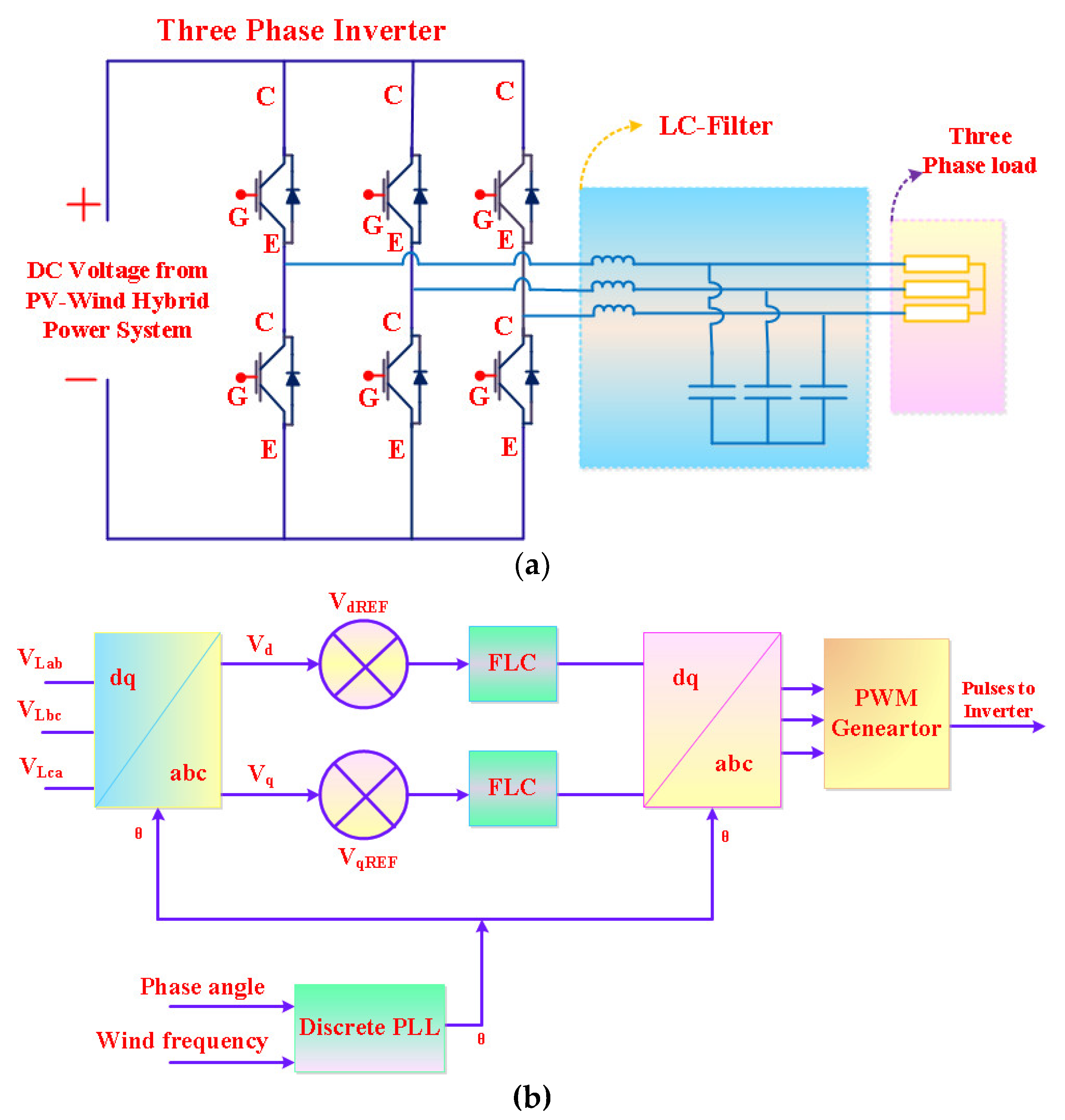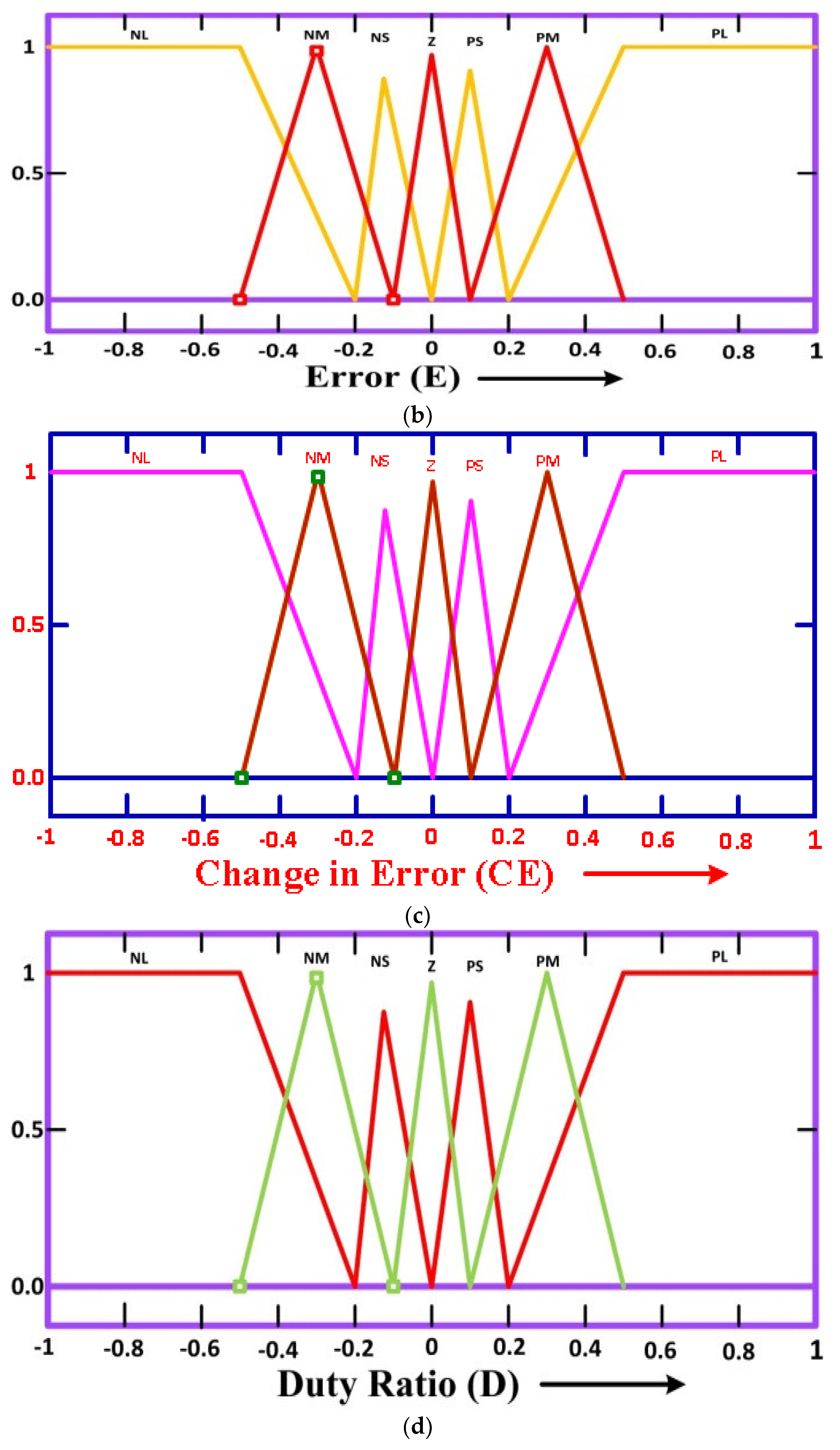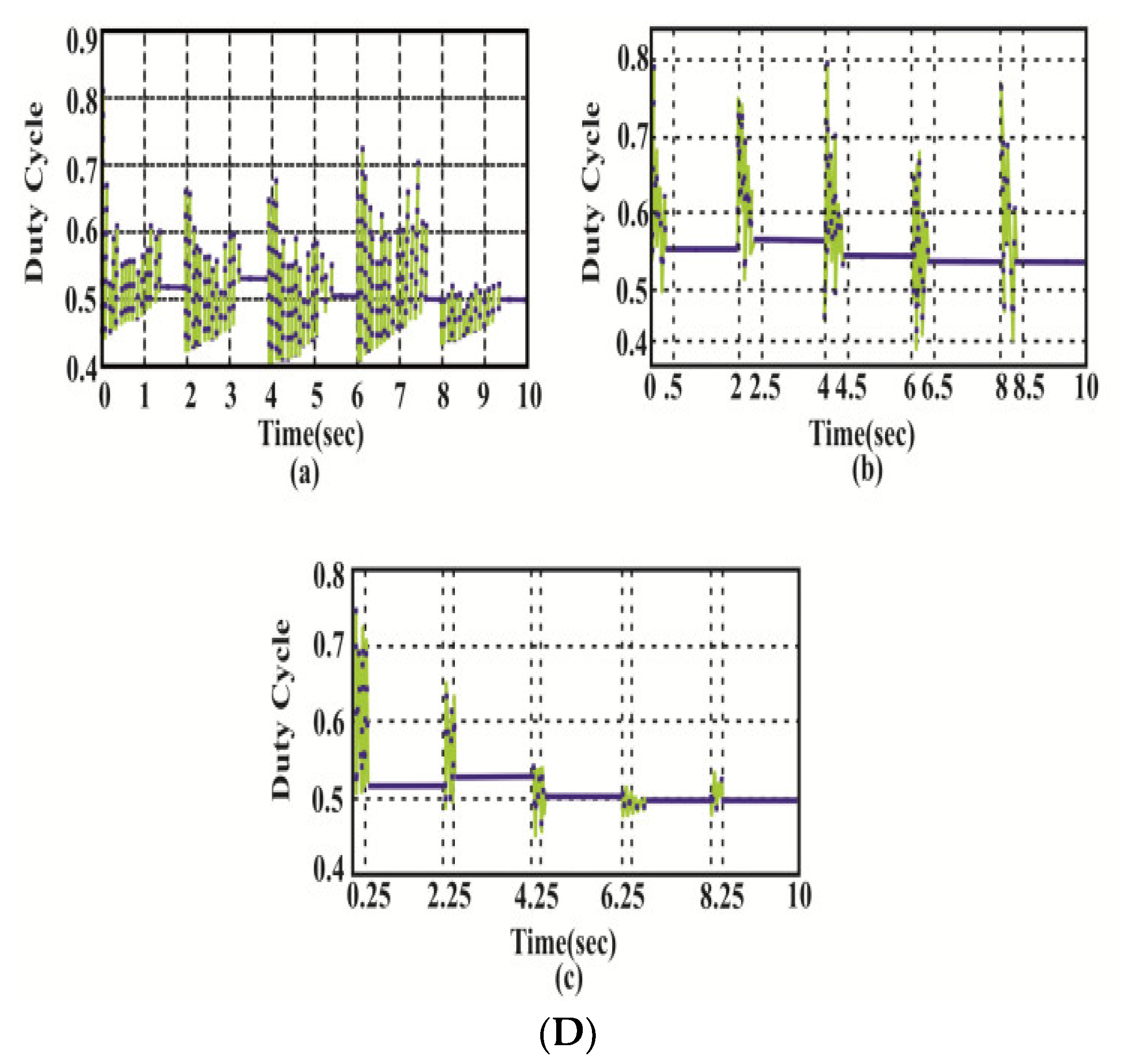An Ant Colony Optimized MPPT for Standalone Hybrid PV-Wind Power System with Single Cuk Converter
Abstract
1. Introduction
- In this research work, the proposed hybrid PV-Wind system performance have been evaluated with PSO, FA, ABC and ACO maximum power point tracking. Compared to other methods, ACO-based MPPT provides lesser tracking period to achieve MPP.
- The optimal power from PV-Wind hybrid system has been extracted with rapid convergence velocity, battery searching performance and simpler hardware implementation.
- Under low wind velocity also, the hybrid PV-Wind system has low battery consumption. The PV and wind energy sources are working independently without influencing one another. Compared to PSO-based MPPT method, the ACO MPPT techniques has seven times faster MPP achievement with accurate convergence velocity.
2. Complete Schematic of PV-Wind System
2.1. PV Modeling
2.2. PMSG Modeling
2.3. Mathematical Modeling of Wind Turbine System

2.4. Electric Circuit-Based Battery Model
2.5. Cuk Converter
3. Ant Colony Optimization-Based MPPT
- (I)
- Mean
- (II)
- Standard deviation
- (III)
- Weight
- (IV)
- Probability of Gaussian function selection
- Step I:
- Parameters (ZP, YP, QP, ξconv) have been initialized.
- Step II:
- The voltage, current and power associated with every ant can be calculated and process has been repeated until YP ant.
- Step III:
- Gaussian function has been evaluated to get ZP new solutions.
- Step IV:
- ZP + YP has been ranked to store YP best solution.
- Step V:
- All 4 steps have been repeated till maximum iterations.
4. Inverter Control, MPPT and Inverter Controller Action with Single Cuk Converter and Experimental Set Up
4.1. FLC-Based Inverter Control
4.2. MPPT and Inverter Controller Action with Single Cuk Converter
4.3. Experimental Set Up
5. Experimental Responses
6. Conclusions
Author Contributions
Funding
Conflicts of Interest
Nomenclature
| Power Coefficient of wind turbine | |
| Density of air | |
| Blade (Wind turbine) radius | |
| Wind velocity | |
| Tip speed ratio | |
| Pitch blade angle | |
| Viscous force | |
| Developed electromagnetic torque | |
| Stator resistance | |
| , | Inductances of Stator winding |
| , | Stator winding current |
| Flux generated by permanent magnet | |
| P | No. of Poles |
| Battery fixed voltage | |
| Polarized voltage | |
| Capacity of battery | |
| Battery current | |
| Amplitude of exponential zone | |
| Inverse time constant exponential zone | |
| Hj(y) | jth Gaussian kernel |
| jth Gaussian function | |
| Standard deviation | |
| Mean function | |
| ɛconv | Rate of convergence |
| QL | Best rank solution |
| AP | Parameters to be optimized |
| YP | Initial random solutions |
References
- Singaravel, M.M.R.; Daniel, S.A. MPPT with Single DC-DC Converter and Inverter for Grid Connected Hybrid Wind-Driven PMSG-PV System. IEEE Trans. Ind. Electron. 2015, 62, 4849–4857. [Google Scholar] [CrossRef]
- Chen, Y.M.; Liu, Y.C.; Hung, S.C.; Cheng, C.S. Multi-Input Inverter for Grid-Connected Hybrid PV/Wind Power System. IEEE Trans. Ind. Electron. 2007, 22, 1070–1077. [Google Scholar] [CrossRef]
- Wandhare, R.G.; Agarwal, V. Novel Integration of PV-Wind Energy System with Enhanced Efficiency. IEEE Trans. Power Electron. 2015, 30, 3638–3649. [Google Scholar] [CrossRef]
- Geng, H.; Liu, L.; Li, R. Synchronization and Reactive Current Support of PMSG based Wind Farm during Severe Grid Fault. IEEE Trans. Sustain. Energy 2018. [Google Scholar] [CrossRef]
- Das, S.; Subudhi, B. A H∞ Robust Active and Reactive Power Control Scheme for a PMSG based Wind Energy Conversion System. IEEE Trans. Energy Convers. 2018, 33, 980–990. [Google Scholar] [CrossRef]
- Ahmed, J.; Salam, Z. An Enhanced Adaptive P&O MPPT for Fast and Efficient Tracking under Varying Environmental Conditions. IEEE Trans. Sustain. Energy 2018, 9, 1487–1496. [Google Scholar]
- Xiao, X.; Huang, X.; Kang, Q. A Hill Climbing Method-Based Maximum Power Point-Tracking Strategy for Direct-Drive Wave Energy Converters. IEEE Trans. Ind. Electron. 2016, 63, 257–267. [Google Scholar] [CrossRef]
- Kumar, N.; Hussain, I.; Singh, B.; Panigrahi, B.K. Self-Adaptive Incremental Conductance Algorithm for Swift and Ripple Free Maximum Power Harvesting from PV Array. IEEE Trans. Ind. Inform. 2018, 14, 2031–2041. [Google Scholar] [CrossRef]
- Khateb, A.E.; Rahim, N.A.; Selvaraj, J.; Uddin, M.N. Fuzzy Logic Controller Based SEPIC Converter for Maximum Power Point Tracking. IEEE Trans. Ind. Appl. 2014, 50, 2349–2358. [Google Scholar] [CrossRef]
- Lin, W.M.; Hong, C.M.; Chen, CH. Neural-Network-Based MPPT Control of a Stand-Alone Hybrid Power Generation System. IEEE Trans. Power Electron. 2011, 26, 3571–3581. [Google Scholar] [CrossRef]
- Priyadarshi, N.; Anand, A.; Sharma, A.K.; Azam, F.; Singh, V.K.; Sinha, R.K. An Experimental Implementation and Testing of GA based Maximum Power Point Tracking for PV System under Varying Ambient Conditions Using dSPACE DS 1104 Controller. Int. J. Renew. Energy Res. 2017, 7, 255–265. [Google Scholar]
- Koad, R.B.A.; Zobaand, A.F.; Shahat, A.E. A Novel MPPT Algorithm Based on Particle Swarm Optimisation for Photovoltaic Systems. IEEE Trans. Sustain. Energy 2017, 8, 468–476. [Google Scholar] [CrossRef]
- Sundareswaran, K.; Peddapati, S.; Palani, S. MPPT of PV Systems under Partial Shaded Conditions through a Colony of Flashing Fireflies. IEEE Trans. Energy Convers. 2014, 29, 463–472. [Google Scholar]
- Sundareswaran, K.; Sankar, P.; Nayak, P.S.R.; Simon, S.P.; Palani, S. Enhanced Energy Output from a PV System Under Partial Shaded Conditions Through Artificial Bee Colony. IEEE Trans. Sustain. Energy 2015, 6, 198–209. [Google Scholar] [CrossRef]
- Ram, J.P.; Rajasekar, N. A novel Flower Pollination based Global Maximum Power Point method for Solar Maximum Power Point Tracking. IEEE Trans. Power Electron. 2017, 32, 8486–8499. [Google Scholar]
- Mohanty, S.; Subudhi, B.; Ray, P.K. A Grey Wolf Assisted Perturb & Observe MPPT Algorithm for a PV System. IEEE Trans. Energy Convers. 2017, 32, 340–347. [Google Scholar]
- Belhachat, F.; Larbes, C. Global maximum power point tracking based on ANFIS approach for PV array configurations under partial shading conditions. Renew. Sustain. Energy Rev. 2017, 77, 875–889. [Google Scholar] [CrossRef]
- Sundareswaran, K.; Kumar, V.V.; Sankar, P.; Simon, S.P.; Nayak, P.S.R.; Palani, S. Development of an improved P&O algorithm assisted through a colony of foraging ants for MPPT in PV system. IEEE Trans. Ind. Inform. 2016, 12, 187–200. [Google Scholar]
- Emerson, N.; Srinivasan, S. Integrating Hybrid Power Source into Islanded Micro grid Using Ant Colony Optimization. In Proceedings of the International Conference on Advanced Computing and Communication Systems (ICACCS-2015), Coimbatore, India, 5–7 January 2015; pp. 1–4. [Google Scholar]
- Banaei, M.R.; Sani, S.G. Analysis and implementation of a new SEPIC-based single switch buck-boost dc-dc converter with continuous input current. IEEE Trans. Power Electron. 2018. [Google Scholar] [CrossRef]
- Pachauri, R.K.; Chauhan, Y.K. Modeling and Simulation Analysis of PV Fed Cuk, Sepie, Zeta and Luo DC-DC Converter. In Proceedings of the International Conference on Power Electronics Intelligent Control and Energy Systems (ICPEICES-2016), Delhi, India, 4–6 January 2016; pp. 1–6. [Google Scholar]
- Farhat, M.; Barambones, O.; Sbita, L. Efficiency boosting for PV systems using new MPPT method. In Proceedings of the of 23rd Mediterranean Conference on Control and Automation (MED), Torremolinos, Spain, 16–19 June 2015; pp. 777–782. [Google Scholar]
- Shiau, J.-K.; Wei, Y.-C.; Lee, M.-Y. Fuzzy Controller for a Voltage-Regulated Solar-Powered MPPT System for Hybrid Power System Applications. Energies 2015, 8, 3292–3312. [Google Scholar] [CrossRef]
- Robles Algarín, C.; Taborda Giraldo, J.; Rodríguez Álvarez, O. Fuzzy Logic Based MPPT Controller for a PV System. Energies 2017, 10, 2036. [Google Scholar] [CrossRef]
- Hong, C.-M.; Ou, T.-C.; Lu, K.H. Development of intelligent MPPT (maximum power point tracking) control for a grid-connected hybrid power generation system. Appl. Energy 2013, 50, 270–279. [Google Scholar] [CrossRef]
- Lin, W.-M.; Hong, C.-M.; Ou, T.-C.; Chiu, T.-M. Hybrid intelligent control of PMSG wind generation system using pitch angle control with RBFN. Energy Convers. Manag. 2011, 52, 1244–1251. [Google Scholar] [CrossRef]
- Ou, T.-C.; Lin, W.-M.; Huang, C.-H. A Multi-Input Power Converter for Hybrid Renewable Energy Generation System. In Proceedings of the IEEE PES/IAS Conference on Sustainable Alternative Energy (SAE), Valencia, Spain, 28–30 September 2009; pp. 1–7. [Google Scholar]
- Ou, T.-C. A novel unsymmetrical faults analysis for microgrid distribution systems. Electr. Power Energy Syst. 2012, 43, 1017–1024. [Google Scholar] [CrossRef]
- Ou, T.-C.; Hong, C.-M. Dynamic operation and control of microgrid hybrid power systems. Appl. Energy 2014, 66, 314–323. [Google Scholar] [CrossRef]
- Ou, T.-C. Ground fault current analysis with a direct building algorithm for microgrid distribution. Electr. Power Energy Syst. 2013, 53, 867–875. [Google Scholar] [CrossRef]
- Ou, T.-C.; Lu, K.-H.; Huang, C.-J. Improvement of Transient Stability in a Hybrid Power Multi-System Using a Designed NIDC (Novel Intelligent Damping Controller). Energies 2017, 10, 488. [Google Scholar] [CrossRef]
- Mellit, A.; Rezzouk, H.; Messai, A.; Medjahed, B. FPGA-based real time implementation of MPPT-controller for photovoltaic systems. Renew. Energy 2011, 36, 1652–1661. [Google Scholar] [CrossRef]
- Liu, C.-L.; Chen, J.-H.; Liu, Y.-H.; Yang, Z.-Z. An Asymmetrical Fuzzy-Logic-Control-Based MPPT Algorithm for Photovoltaic Systems. Energies 2014, 7, 2177–2193. [Google Scholar] [CrossRef]
- Santra, S.B.; Behera, S.K.; Panigrahi, C.K. Stability Analysis and Control of hybrid Solarand Wind System through NI c-RIO. In Proceedings of the 7th India International Conference on Power Electronics (IICPE), Patiala, India, 17–19 November 2016; pp. 1–6. [Google Scholar]
- Broujeni, S.T.; Fathi, S.H.; Kumle, A.N. Effects of Fault Condition on the Performance of Hybrid PV/Wind Power Systems. In Proceedings of the 11th International Conference on Electrical Engineering/Electronics, Computer, Telecommunications and Information Technology (ECTI-CON), Nakhon Ratchasima, Thailand, 14–17 May 2014; pp. 1–6. [Google Scholar]
- Saidi, A.; Chellali, B. Simulation and Control of Solar Wind Hybrid Renewable Power System. In Proceedings of the 6th International Conference on Systems and Control, Batna, Algeria, 7–9 May 2017; pp. 51–56. [Google Scholar]
















| S.N. | Parameters | Values |
|---|---|---|
| 1. | Inductor (LA = LB) | 0.5 mH |
| 2. | Capacitor (CA = CB) | 1.5 µF |
| 3. | Frequency of Switching | 10 KHz |
| 4. | Diode | 500 V/7 A |
| 5. | MOSFET (Power Switch K) | 600 V/12 A |
| S.N. | Parameters | Values |
|---|---|---|
| 1. | Total iterations | 250 |
| 2. | Size of Population | 10 |
| 3. | Produced random solution | 8 |
| 4. | Rate of convergence | 0.35 |
| 5. | Best Rank solution (QL) | 0.85 |
| S.N. | Techniques | Tracking Time (Avg.) |
|---|---|---|
| 1. | PSO | 5.1 s |
| 2. | FA | 2.75 s |
| 3. | ABC | 0.75 s |
| 4. | ACO | 0.38 s |
| S.N. | Parameters | Values |
|---|---|---|
| 1. | PV rated power | 200 W |
| 2. | Wind generation (Rated) | 200 W |
| 3. | Stator and Rotor resistance | 4.3 Ω, 3.8 Ω |
| 4. | Number of Poles | 4 |
© 2019 by the authors. Licensee MDPI, Basel, Switzerland. This article is an open access article distributed under the terms and conditions of the Creative Commons Attribution (CC BY) license (http://creativecommons.org/licenses/by/4.0/).
Share and Cite
Priyadarshi, N.; Ramachandaramurthy, V.K.; Padmanaban, S.; Azam, F. An Ant Colony Optimized MPPT for Standalone Hybrid PV-Wind Power System with Single Cuk Converter. Energies 2019, 12, 167. https://doi.org/10.3390/en12010167
Priyadarshi N, Ramachandaramurthy VK, Padmanaban S, Azam F. An Ant Colony Optimized MPPT for Standalone Hybrid PV-Wind Power System with Single Cuk Converter. Energies. 2019; 12(1):167. https://doi.org/10.3390/en12010167
Chicago/Turabian StylePriyadarshi, Neeraj, Vigna K. Ramachandaramurthy, Sanjeevikumar Padmanaban, and Farooque Azam. 2019. "An Ant Colony Optimized MPPT for Standalone Hybrid PV-Wind Power System with Single Cuk Converter" Energies 12, no. 1: 167. https://doi.org/10.3390/en12010167
APA StylePriyadarshi, N., Ramachandaramurthy, V. K., Padmanaban, S., & Azam, F. (2019). An Ant Colony Optimized MPPT for Standalone Hybrid PV-Wind Power System with Single Cuk Converter. Energies, 12(1), 167. https://doi.org/10.3390/en12010167






